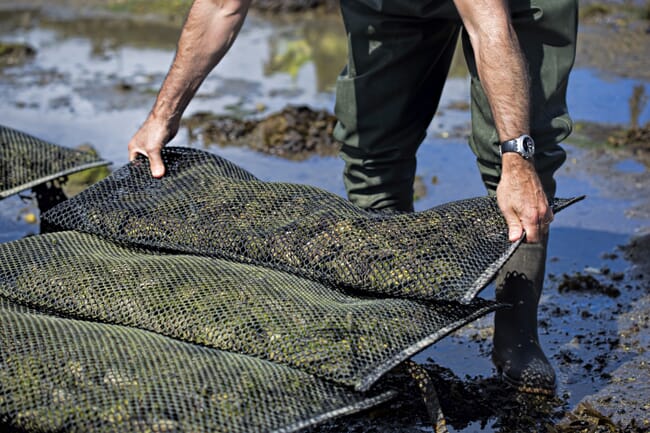This was among the key themes to emerge from the Shellfish Association of Great Britain’s Annual Conference. Held in Fishmonger’s Hall on 14-15 May, those touching on this topic included Alex Adrian of Crown Estate Scotland and Mark Dravers of Guernsey Sea Farms. They were among a number of presenters who discussed methods for strategically expanding the UK shellfish sector, as well as highlighting the challenges it could face in its future trajectory.

© Seafish
The presenters agreed that there are multiple reasons why the UK should welcome the expansion of the shellfish industry. From the perspective of Crown Estate Scotland, Adrian noted, shellfish farms can provide lucrative and stable employment in rural areas. For Scotland in particular, industry expansion can improve economic resilience, increase economic diversity and give local businesses a strong presence in the aquaculture community. From an environmental perspective, shellfish farming is a net positive too.
Moreover, Dravers pointed out, shellfish, oysters especially – naturally capture carbon. If the industry expanded in a way that prioritised sustainability and accessibility, shellfish aquaculture could become a core piece of the UK’s agricultural portfolio, he added.
Despite these positives, the industry faces challenges. Current snapshots indicate that the majority of Scottish shellfish farms produce less than 200 tonnes per year, which means that the industry is susceptible to financial shocks if/when commodity markets fluctuate. Production needs to be scaled up sustainably in order to insulate producers from market pressures.
Producers face additional challenges in the sector. New entrants to the industry could have difficulties getting financed. They could also face competition for access to water space and infrastructure. Obtaining planning permission remains a significant hurdle; the licensing and planning process is expensive, complex and doesn’t have a guaranteed outcome for the applicant.
The policy perspective
In response to these challenges, Adrian drew the audience’s attention to Crown Estate Scotland’s Critical Mass Development plan. This policy document has identified the reasons for Shetland’s success in mussel farming and discusses ways that success could be replicated on mainland Scotland.

Analysis from the Crown Estate indicates that, in order to meet the challenges inherent to the industry, producers should prioritise business resilience and building critical mass. The report suggests that producers work collaboratively to achieve growth. It also makes the case for trialling shared capital investment, which would allow the industry to address its challenges and grow sustainably in the coming years.
Adrian was quick to assert the willingness of Crown Estate Scotland to facilitate industry expansion. He encouraged shellfish producers to use the agency as a resource to improve their development prospects. Assistance from the Estate could also help producers tackle the challenges of the planning process (a step that thwarts many new shellfish farms). The agency, he emphasised could also assist with different forms of financing. When expanding, the industry needs to lean into the arguments that resonate with key stakeholders. Mentioning the employment opportunities, the expansion of the sustainable “blue economy” and that shellfish farms positively contribute to the local ecosystem could reduce NIMBYism. Beginning new proposals with these arguments could cultivate support from the surrounding community.
The industry perspective
Meanwhile, Dravers’ opinions were informed, as his talk illustrated, by his 50-year career in the shellfish sector. When focusing on the challenges facing the UK oyster industry today, he conceded that, “the size of the industry is small, and out of balance with the regulatory burdens”.
In his experience, one of the biggest challenges in the industry is the lack of public awareness of what oyster farming entails. Many planning and development proposals concerning shellfish farms are turned down due to a perceived “loss of visual amenity”. Additionally, some species of farmed oysters – notably Crassostrea gigas, the Pacific oyster – are considered “alien” to Britain, and their cultivation is restricted to protect native species. Dravers was quick to point out that these objections are not supported by the facts. Shellfish farms are rarely an eyesore, and oysters do not represent a significant threat to Britain’s ocean habitat.
According to Dravers, an additional challenge facing the shellfish industry is the lack of coordination between regulators, industry members and academia. Academics do not always disseminate their research in a timely manner and, like many other industries, the relationship between regulators and shellfish producers is adversarial. This lack of coordination has meant that regulations concerning invasive species and development plans may not reflect the needs of producers. It also means that many innovations piloted by researchers are not adopted across the industry.
Dravers was keen to make the case for expansion despite these challenges. In his view, shellfish farming can thrive if producers tap into consumer demand and encouraged new developments in the industry. If regulators adopted evidence-based policy and academics worked alongside shellfish producers, he concluded, then the sustainable scale-up of the industry can be achieved.




